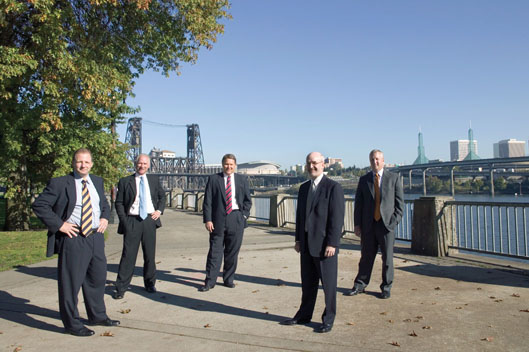
JBL&K’s board (from left): Dan Romain, President; Ron Graybeal; Chuck Floberg, CEO and Chairman; Bill Mooney, Executive Vice President and Property & Casualty Manager; and Mike Cranston stand alongside the Willamette River.
MARKETING AGENCY OF THE MONTH
CREATING A COMMUNICATION BUSINESS
Oregon agency sees its job as communication, not insurance
By Dennis H. Pillsbury
 |
JBL&K’s board (from left): Dan Romain, President; Ron Graybeal; Chuck Floberg, CEO and Chairman; Bill Mooney, Executive Vice President and Property & Casualty Manager; and Mike Cranston stand alongside the Willamette River. |
JBL&K in Portland, Oregon, is an established name with a 132-year tradition. It is a sales and profit powerhouse with 89 employees (71 in Portland and 18 in an office in Medford) and revenue in excess of $15 million, with 75% coming from property/casualty business and 25% from benefits. That’s $168,000 per employee and a $78,000 spread per employee. The pre-tax profit is approximately 22%. That’s impressive. However, it is even more impressive when compared with the agency of only four years earlier.
The agency had reached a point, as many agencies do, where people had become comfortable with where they were and the agency wasn’t growing at a rate that would allow it to internally perpetuate. “Our markets were questioning how we were going to be able to move forward into the future and continue as an independently held agency,” notes Dan Romain, president and board member. “We had 73 employees and revenues of about $6.9 million, for revenue per employee of only $92,500. Our spread per employee was $22,300. Our pre-distribution pre-tax profit was about 4%. That’s not good. A number of our carriers were talking about canceling us.”
Newly elected CEO and Board Chairman, Chuck Floberg, was in the driver’s seat and had to chart the agency’s future. “I looked at this agency that I’d been with for 15 years at that point and realized that we needed to change. As CEO, I felt not only did we need to change from a numbers and financial standpoint, but what concerned me more was the culture of our organization. I wanted to ensure that JBL&K became an energetic, vibrant place to work and one that would attract high performing, quality individuals. A lot of agencies fail because of culture and we didn’t want to be one. The challenge was how to make the economic changes and, at the same time, balance the cultural change needed to achieve our goals.
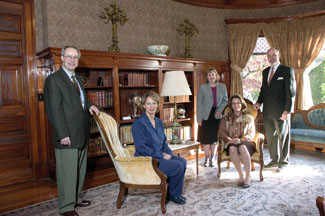 |
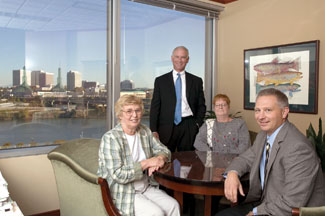 |
From left: Allan Hunt, Executive Director of William Temple House, with the JBL&K nonprofit team, Sandy Taylor, Julie Langdon, Audrey Strong, and Vice President Dennis S. Doherty. JBL&K insures Temple House, which is operated by the Episcopal Laymen’s Missionary Society to provide crisis counseling and other assistance in the community. |
JBL&K’s public sector team includes (from left): Susie Flukinger, Ron Graybeal, Jill Johnson and Ron Cutter. |
“I have to give a tremendous amount of credit to our previous chairman, Denny Ferguson,” Chuck continues. “Before he retired, he let us take the steps that were necessary to change from a staid organization to a dynamic sales-oriented agency. There were a lot of difficult decisions that had to be made, but for me the hardest was to bring in two outside people. Our previous attitude was, ‘This is our problem and we want to fix it ourselves.’ Realizing that culture change required outside talent, I brought in Bill Mooney, and he led us to Dan Romain.” Bill is P&C division manager and marketing manager and a member of the board.
Bill Mooney came to JBL&K from Royal, where he had spent six years in the field. Prior to that, he had seven years at Continental and nine at AIG. “I’d worked with hundreds of agencies over those years and brought what I’d learned to JBL&K,” Bill says. “Chuck and Dan supported the development of a strong marketing department and a true sales culture. We preached the religion of profit and started to develop a sales culture in the agency.
“I pointed out that I had never run into an agency that got fired over price; it was always over service,” Bill continues. “We had to make certain that we gave our clients the best possible service and that the companies we represented did so as well. To make certain of that, we needed leverage with our lead companies and that meant increasing volume and providing profitable business. Our volume with Travelers, for example, went from less than $1 million to $8 million. Our volume with Chubb and Safeco doubled.
“Internally, we made sure that every discipline was covered,” Bill adds. “We have experts in safety, claims and loss control who work with our clients to help reduce or eliminate claims whenever possible, to mitigate loss when claims do occur, and to make certain that claims are paid in a fair and timely manner. Our focus shifted to coverage and service, with price remaining an important but not overarching concern. More than 80% of our new business is based on a broker-of-record letter. That’s certainly an indication that we’re doing something right.”
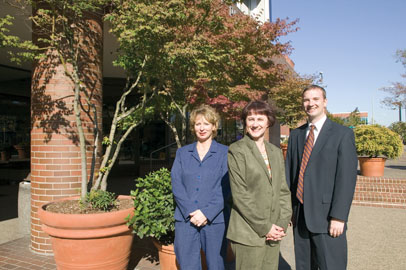 |
 |
Helping to develop new program areas are (from left): Sandy Taylor, Maureen Schleich, and Vice President Steve Miller. |
JBL&K’s construction team (from left): Shari Welborn, Lori Whittlesey, Craig Payne, Pia Nicastro, and Danielle Carroll. |
Dan remembers back to four years ago when the cultural change began to take place. “It’s not easy to turn a large ship and we realized we had to make certain everyone was steering in the same direction. Clearly defining our mission, goals and strategies ensured that the management team was pulling together to support those who had to make and carry out the tough decisions. Our messages were tough at times, but they were honest, clear and consistent.
“We knew what was wrong. Most owners of agencies with problems know exactly what those problems are but often don’t have the guts, votes or stamina to deal with them. You have to have the courage to face people. We opened the doors to everyone. Employees knew some of the solutions and we wanted to let them know we were ready to listen. We invited them to try new things. We even jokingly told our people to ‘make a mistake or you’re fired.’ We wanted them to start feeling and acting like they were part of the agency again. We wanted to let them know that the only bad thing was to do nothing. Mistakes were welcome because it meant the person was acting.
“At the same time,” Dan adds, “we also wanted to make it clear that we were not overturning everything. But the only tradition to which we wanted to adhere was ‘take care of the customer.’ We let all the employees know that we are all partners in this endeavor and that one of our core philosophies is that we would all talk to our partners, not about them. We made this a communication business, not an insurance business.”
He concludes that the process certainly wasn’t easy or without pain. “We had greater than normal turnover as some employees had difficulty accepting the changes and, at the same time, a new board was put in place as previous board members reached retirement.”
Bill Mooney notes, “We owe a great debt of gratitude to Assurex which funded the perpetuation that allowed all this to happen. They believed in what we were doing and backed us with financing.”
Chuck comments, “Through all that was happening, we were able to retain high morale. The new people who came in and those employees who believed in the process all saw what we were trying to do and the results we were able to achieve. We stopped spending time artificially motivating people and started spending time helping them to do their jobs more effectively. We met with every new hire after 60 days and asked how he or she felt about the company.”
Bill adds, “Our goal was to make it fun—to rebuild the energy and enthusiasm that seemed to have been lost over the years. As we succeeded, we started to attract great people and great clients and great companies. We bought new computers and a new automation system, going from Redshaw to AMS 360. We refurbished the offices. And we made sure that everybody shared in our success through salary increases and bonuses. We also developed criteria for owning stock.”
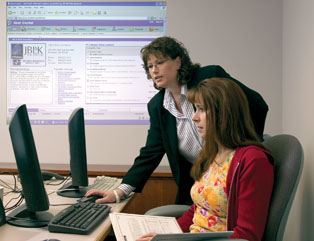 |
New computers, a new automation system and refurbished offices were added as JBL&K continued its rush forward. Pictured above is Margaret Davis, AMS 360 Practice Leader, working with new employee Danielle Carroll. |
Ron Graybeal, public sector practice leader/account executive, board member and corporate secretary, has been with the agency for 17 years and has “seen a lot, good and bad. I think the one thing that was most critical to our success was the cohesive nature of the board and their trust in each other. Once you have cohesive leadership, it’s much easier to get things accomplished. There were a lot of difficult, but necessary decisions that were made. We parted with some long-term employees who did not embrace our new philosophy. But what was most interesting to me was that, as we raised the bar, morale went higher and higher. Today, you see ‘A’ players wherever you look here. The quality of our people is tremendous and the culture is very positive.”
Some of Ron’s responsibilities include managing the production staff. “The focus on sales resulted in an internal reorganization that freed up the producers to spend most of their time selling. We had producers last year do $250,000 in new business and this year, some will exceed $300,000. We also moved to a team concept with teams dedicated to specific business disciplines such as public sector, construction and nonprofits. I run the public sector team. What impresses our clients the most is the depth of the teams and the resources we bring to the table. The risk management services that Bill mentioned earlier also have been one of the principal reasons for our success in the public sector market. We win because of the teams.”
The agency also is active in developing new program business. Steve Miller, commercial producer/account executive, is the program business practice leader, chosen for his ability to develop business across several disciplines. “The goal here is to create good strong paths for new producers to run on,” Steve says. “That’s the basic tenet of our program focus.”
Steve continues, “We insure virtually every temp agency in the state. Workers comp has been the driver there. We’ve also gotten into the long term care industry professional liability.”
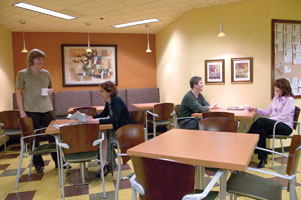 |
A few employees enjoy the newly designed break room. |
Mike Cranston, commercial producer/account executive, runs the corporate services and personal lines department and is on the board. “We’re trying to dovetail personal lines with commercial. Our objective is to grow with our markets, and cross-selling is definitely important. In the small business environment, a BOP sale can lead to benefits and personal lines business. You don’t have to slay the elephants to succeed. We just use fundamental blocking and tackling—establish the relationship with the client and keep in touch. Personal lines is only about 10% of total revenues right now. But personal lines grew 22% last year and we plan for it to become a more important segment of our business.”
Dan and Chuck agree; the agency has come along way in its 132-year history. The challenges of the last four years have forced difficult decisions, but having a cohesive board in conjunction with the communication of a clear mission and strategies, along with the development of a culture that supports the goal of remaining independent ensures a future as a dynamic and viable organization for employees, clients, markets and shareholders.
JBL&K now is the largest independent agency in Oregon by a factor of two. Its goal is to become one of the top 100 agencies in the next three years. Based on what has been accomplished thus far, it would seem quite feasible. It is an agency that well deserves recognition as our Marketing Agency of the Month. *